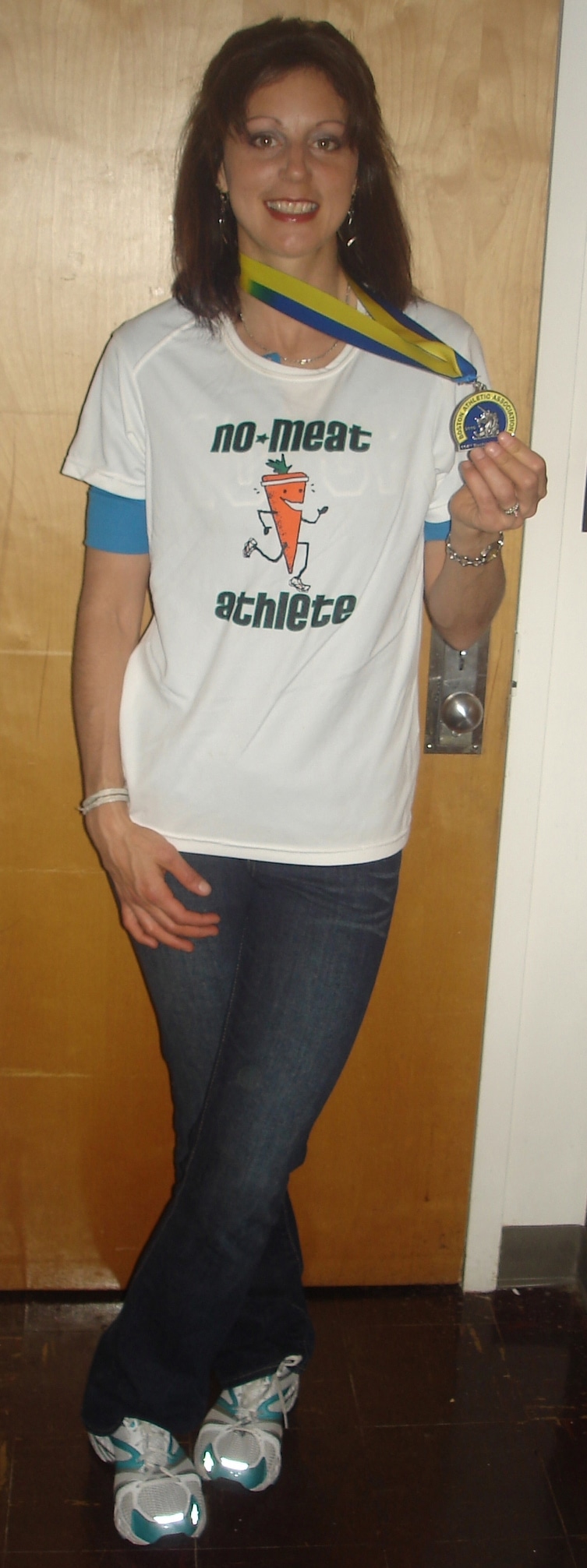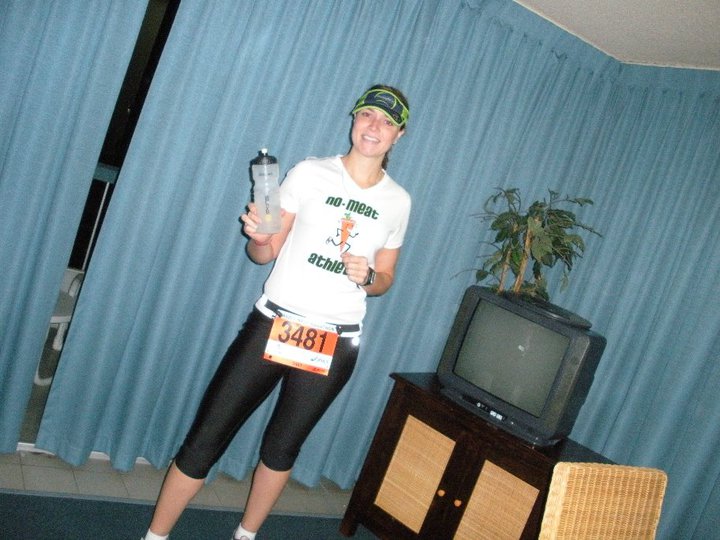Answers to Your Questions about Protein, Chia, Flax, Soy and Pre- and Post-Workout Nutrition
People ask me a lot of questions by email.
When they want me to make an entire diet plan for them, I ignore them. When they ask “Do You Want Natural Love Muscle Enhance?” I delete them.
But when they ask nice, short, interesting questions, I love answering email questions. And I got a whole slew of good ones last week, so I decided to answer five of them on the blog for all to see.
These are my opinions. I’m not a doctor and I don’t know everything. And I get lost every time I drive somewhere new without a GPS, without fail.
After you’ve read/skipped my answers, check out photos of awesome readers in NMA shirts at the end of the post!
Here goes nothin’.
I’m a distance runner in California and was wondering if you could suggest a protein powder that is suitable for endurance athletes. Obviously I’m not looking for protein powders that body builders use, but I think I’m in need of some extra calories during the day. Do the vegetarian protein powders have all the essential amino acids in them? What are the advantages and disadvantages of whey protein?
Some specific product suggestions would be great.
Thanks,
Ryan
Ryan,
If you’re just looking for extra calories, don’t rule out a meal replacement supplement instead of just pure protein. If, however, you think your diet is lacking in protein, then a protein powder might be the way to go.
I like hemp protein because it’s minimally processed—the powder is green, not white as most processed powders are. It’s also environmentally-friendly and is nearly raw, another plus. And yes, it contains all the essential amino acids. The biggest downside to hemp protein is that it can be expensive: The brand I use, Living Harvest, costs about a dollar per 13-gram serving of protein. There are cheaper brands, though.
So I put a few scoops of hemp protein powder in my smoothie in the morning. But immediately after a workout, especially a speed workout or weight-training, I use Vega Sport Performance Protein (affiliate link). It’s made from a variety of plant protein sources—sprouted whole grain brown rice, green pea, hemp, alfalfa, and spirulina—and has more protein by volume than pure hemp protein. It, too, has all the essential amino acids. It’s even more expensive than hemp protein though, so I save it for times when my muscles are really broken down.
The downsides of whey protein are similar to the downsides of cow’s milk in general, and with the additional processing to make whey protein isolate, it’s even more unnatural and acid-forming. One thing whey has going for it is that it’s relatively cheap, but nutrition is something that I don’t mind spending extra money on.
[In reference to Fuel Your Run With Pinole and Chia] These recipes look great, thanks for offering them. I have a question that may seem simplistic, but I’m unsure of the best answer. If I were to eat the buckwheat pancakes the morning of a marathon, how long before the run should I eat a breakfast that big?
Thanks!
August
August,
Thanks for buying the book! As you know, the buckwheat pancakes are about 225 calories each with almost 30 grams of carbohydrates. According to Core Performance Endurance, a book I like a lot, you want 1.5 grams of carbohydrates per pound of bodyweight for your meal 3-4 hours before the event, and about half that amount two hours before the event. (This assumes you’re talking about an endurance event, not a 5K or something shorter like that.) So, if you weigh 150 pounds, that’d be 7 or 8 pancakes if you’re eating 3-4 hours beforehand. Seems like a lot, but they’re small. I’d probably eat a few less than that and get some of the carbohydrates from syrup or agave nectar on them.
As far as I can tell, you’re supposed to eat both of these meals (3-4 hours beforehand and 2 hours beforehand). And they want you to eat again an hour before the event! Personally, I can’t eat this much on a race morning, so certainly you should experiment during training to figure out what works best for you.
Hey Matt, so I’ve seen you promote white chia over black but in my research based mostly on Wayne Coates’ findings there is virtually no difference between the two. I was wondering your take on his assessment…as well as his findings on the possible “non nutritional” and potentially toxic attributes of flaxseed.
Kevin
Kevin,
Interesting stuff about white and black chia being pretty much equivalent nutritionally. Honestly, all that I know about the distinction is from Thrive Fitness where Brendan Brazier describes white chia as an heirloom variety grown in richer soil than most black chia, resulting in higher vitamin, mineral, and nutrient content. Coates’ chart doesn’t say anything about mineral content, only protein and fatty acids. I’m curious as to why he didn’t include anything else on his chart.
As far as flaxseed being bad for you—or at least, not good for you— I have heard before that there are some risks to the liver and kidneys associated with consuming too much flaxseed oil (over three tablespoons per day, I believe). I limit my own intake to about half a tablespoon per day, but I also put some whole flax in my smoothie. I think you’d have to try very hard to consume enough whole flaxseed for it to be a problem.
The idea that flax could be harmful is certainly interesting, but it seems there’s much more science pointing to benefits than to potential harm. Keep in mind that Coates is in the business of selling chia, so it’s not all that surprising that he’d want to cite evidence showing that flaxseed (in many ways an alternative to chia) is bad.
I have a question about the post workout “window.”
I am a member at this awesome gym but it is about 15-20 minutes away from my house. They do have a great cafeteria there, but of course can’t make the types of shakes in thrive. So what am I to do? It takes me about 20-30 minutes to shower and get dressed after my workouts and then the additional trip home. When I get home I scurry into my kitchen and try to fix up a post workout shake as fast as I can. I am pretty sure however that by then time is up. Maybe you can suggest a way I can recover properly? Is it possibly to make the smoothies before I go to the gym and store it in some kind of special container for later? You see, I’m not too sure about this because I always heard they should be freshly drank. Any suggestions would be very much appreciated. I look forward to hearing from you. Thank you.
Stephanie
Stephanie,
I wouldn’t worry too much about making a Thrive smoothie immediately after your workout. Sure, that’s probably ideal, but immediately after your workout is a time when I like to eat some of the food that normally I wouldn’t eat, especially refined carbs like white bread, white rice, and sugars. It gets into your bloodstream quickly, so that’s one time it’s okay to eat those foods. And I’m always craving starchy food after a workout, so I figure there’s probably something to that.
Still, liquid form is probably the fastest at delivering the nutrition to your muscles, so you could drink some fruit juice, a sports drink, or even a carbohydrate powder that you just add water to. Plain old fruit is good too. And I don’t see any problem with drinking your smoothie a few hours after you make it, as long as you can keep it cold.
Don’t forget, you want to get one part protein for every four or five parts carbohydrate, so include something with protein. I like hummus on a pita. Or a handful of nuts. You can probably pack something like this along, right?
What do you know about soy / tofu being toxic? I’m hearing very negative things.
Thanks.
Cheryl
Cheryl,
I’ll go with Michael Pollan on this one and say that if a diet has survived for thousands of years then it probably has some merit. Soy and tofu have been part of some Asian diets for a very long time. Obviously too much of any one food is bad, as is consuming highly-processed versions of anything, such as soy protein isolate.
With soy finding its way into so much manufactured food in the Western diet, I can see how perhaps adding any additional soy could be harmful (even tofu, which doesn’t take much processing). But if you don’t eat much packaged, processed food, then I think soy products like tofu and tempeh are an excellent way to get protein. I wouldn’t rely on any one source for protein, however, and soy is no exception.
Thanks for your questions, everyone!
No Meat Athlete shirts are back in stock
If you’ve tried to order a No Meat Athlete shirt in the past several weeks, especially a popular size, you likely found it sold out. But we just got another shipment in, so supplies are replenished for the time being. If you want one, get it now before they run out again.
I love when people send me pictures of themselves rocking the carrot at their races. Here are a few shots from the latest crop.
Thanks for the photos, everyone, keep them coming. If I forgot anyone who sent me a photo, it’s because I’m the most disorganized person in the world and I lost it.
By the way, what do you think of the new NMA site design? Did you see the new Get Inspired page?
Leave a Reply
men’s large technical shirts are still showing as out of stock
I wore my NMA shirt at a 5k in July! I posted about it here :
http://foodosaurusrex.wordpress.com/2010/07/22/running-and-food-are-a-perfect-combination/
I got lots of looks and quite a few compliments!
Thanks for this. This is really helpful! I also wonder about the “window” since I can never eat within an hour. I’m going to start bringing high protein “snacks” with me to eat directly after working out before my larger meal later on. I also agree with you on the soy. In its purest form it can’t be too harmful if most Asian cultures have been eating it for years. Unfortunately, most of the soy in the US is genetically modified and highly processed. That’s why I like to stick to fermented soy (tempeh) and tofu and rare occasions.
I love your “Get Inspired” page!! Your post on making training a must helped me get out the door today. Thank you!
Here in the Heartland, I have been wearing my NMA shirt with proud defiance. Not just in The Heartland, but all over the East and West Coasts. Usually, I get crabby looks. Yesterday I got the first ever positive comments. A husband and wife each passed and said “Great shirt!” It was a big personal best moment for me.
This shirt is awesome, wicks beautifully and dries almost instantly.
With regard to extra protein for endurance athletes Nacy Clarke in her writings questions the need for additional protein if you are consuming a healthy diet (vegan or otherwise). That being said I do add protein powder to my smoothies, though I do not drink them everyday and when I do they are as a meal replacement. My drink of choice after a run or gym workout is good old chocolate milk. I am currently using Garden of Life Raw Protein. Scott Jurek uses Jarrow Fermented Soy Essence (and that boy can run!). I guess the protein debate will go on and on, all we can do is try and find what works best for each of us. Thanks for the great post.
While I can appreciate that soy has been around for a long time, it definitely messes with my system when I eat it. Soy has a decent amount of phyto-estrogen, and it seems to wreaks havoc on my endocrine system. Perhaps I’m just extra sensitive to it, but I sleep terrible after eating soy products (tofu, soy milk, etc) 100% of the time. Plus, I’m a guy, and I don’t really want any extra estrogen in my body!
hi, I just stumbled upon your site and I love it! While I may not run, I am on my college swim team, and as a vegetarian, I often feel like I’m in the minority and am left out when nutrition is addressed with the rest of my team. Just reading this post has answered so many questions for me!
p.s. I totally want to rock one of your shirts at a meet!
Great point on the soy by Michael Pollan. I had totally forgotten he touched on that. Glad to be reminded of that because I think I tend to downplay soy too much for no real reason, other than the few negative things I have heard.
-
Caleb, I’m actually not positive that he ever mentioned this about soy, but he certainly has talked about this general idea with respect to lots of cultures. But I think he’s specifically mentioned Asian diets before, soy or not.
Protein:
ALL plant foods have ALL essential amino acids. Check the USDA database, looking at the eight essential amino acids, notice that are NO ZEROES. It has to be that way, otherwise humans would have some sensory mechanism to detect the different amino acids.
Tarahumara:
The traditional Tarahumara diet is 90% kcal from TWO foods: corn and beans. Those are the true Tarahumara “superfoods”.
Beware the “superfood” bandwagon, I suspect it may have no clothes. But it clearly has well-dressed marketers.
Hi it’s Jennifer from Living Harvest. Thanks for recommending Living Harvest protein powder. We are glad you enjoy it!
Thank you thank you thank you! The question of how to eat mostly vegan and fuel for running has been rolling around in my head for a few months, after attempting my first half-marathon… 7 weeks left for the next one… and I just followed a link from a Tim Ferris tweet and found you! Totally loving it! Big fan of chia and spirulina, and quinoa… and allergic to all nuts, so am glad to find alternative energy bars… I’m totally on board!











I tried to order a Men’s Large – says it’s out of stock.